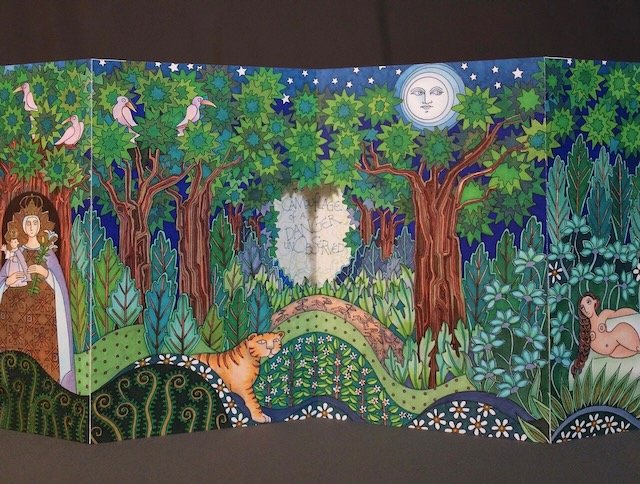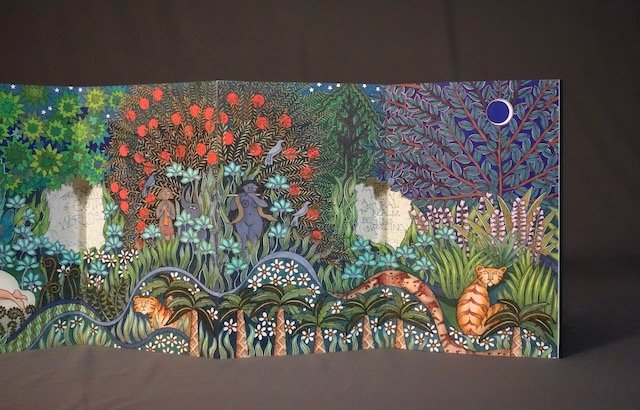Tiger In the Forest
The angle of our regard defines the space an object or entity occupies in our hearts and minds. It becomes the place where we construct our personal metaphors.
We view forests through many lenses, seeing them as timber, habitat, biome, interconnected biological systems, food, and sanctuary. Forest is the source of ancient stories that are tied to the deepest roots of our humanity. It is the essence of wild but also a platform for introspection & sacred contemplation.
Through one lens we see raw resources, ripe for profit. Another lens reveals rich ecosystems which are opening multiple layers of understanding about the complex mechanics of our planet.
While working on Tiger in the Forest, I came to realize how deeply ingrained forests are in our visual metaphors. Examining paintings of my favorite artists from the late 1700’s through the 1800’s, I observed strong connections between each artist’s world view and how they personified forests in their art. Looking beyond and outside of landscapes they found in forests mystery, danger, untamed nature and Eden reclaimed.
In Tiger in the Forest, I pay homage to these painters by blending some of their motifs into my paintings – a form of collaboration which adds a historical layer to my own visual vocabulary. I’ve chosen a two-sided, three-dimensional structure to emphasize some of the many, many dualities in which our culture regards forested environments. I hope that Tiger in the Forest will inspire viewers to pause to consider looking at our natural resources through a different lens.
1.
Edward Hicks: The Peaceable Kingdom, 1820
As a Quaker preacher, the Biblical quote from Isaiah 11:6 – 8 (“The wolf shall lie down with the lamb …”) held special meaning for Hicks. He painted, by some estimates, over 100 interpretations of the quote, titling them: The Peaceable Kingdom. Each of the paintings portrays an ideal world that exists between the wildness of forests and the order of the civilized world. It is a place of perfection that doesn’t reside in one environment or the other.
2.
Anonymous Cuzco school artist: Our Lady of Valvanera, 1770 – 1780
Quechua & Mestizo artists during the Peruvian colonial period were Jesuit -trained in European art techniques. These indigenous artists produced masterful paintings which, to my eye, always contain slight quirks of cultural mistranslation – angels dressed as Spaniards carrying rifles -- South American jungle birds perched in European forests.
Lady of Valvanera tells the story of Nuno Onez, a Spanish hermit priest, who is led into a forest by a hive of bees to retrieve a priceless Madonna, hidden hundreds of years before in a giant oak tree. It is a story of how a forest can hide secrets but also reveal treasure.
3.
William Blake: The Tyger, 1794
Blake’s illustrated poem is contained in his book, Songs of Experience. In it, he draws a tiger emerging from the forest to be confronted by a series of questions touching upon dualities within the Christian universe. “…Did he who made the Lamb make thee? ...” How do we deal with the contrasts in life, where beauty & savagery, harmony & discord exist at the same time?
While Blake posits these questions, the tiger walks in the liminal zone between extremes.
4.
Henri Rousseau: The Dream, 1910
Although Rousseau never left France, he created paintings depicting foreign worlds inhabited by his imaginings of exotic enchantment. In this painting, a naked Eve reclines on a green velvet sofa -- unconcerned that she’s been plopped in the middle of a dense jungle. It’s a naive view of foreign lands where natives serenade from the underbrush and no danger is in sight.
5.
Henri Rousseau: The Snake Charmer, 1907
In this earlier painting, Rousseau’s Eve is not a foreign visitor, but native-born to Eden. She understands the forest’s dangers and how one lives in harmony with the environment.
The Tiger and the Forest is inkjet printed on superfine cover paper from original ink paintings
Art, design and poetry by: Mari Eckstein Gower
engineering & Fabrication by: Kat Gower
This is an edition of 5 books created in 2023







